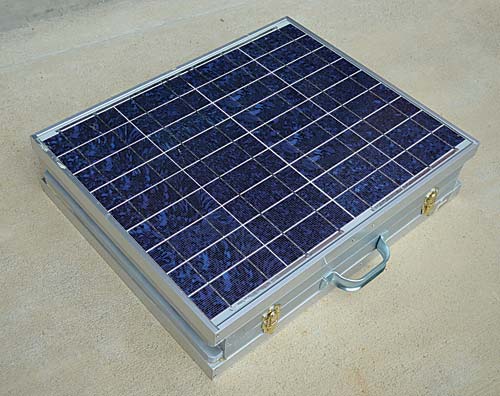 |
|
| Issue #150 • November/December, 2014 |
Completed solar suitcase project
From time to time, people call to ask what we have for emergency solar power suitable for a bug-out bag. Naturally, my first suggestion is one of the many fold-up flexible solar modules available in multiple sizes. However, since these are made for daytime recharging batteries and electronic devices, they provide no power at night and during storms. These people didn’t need a fold-up solar charger that fit into a bug-out bag they needed a fold-up solar charger that is a bug-out bag!
This article will show you how to make a solar power system in the form of a portable suitcase. This design is easy to build since it is made using two identical solar modules of almost any size, depending on your power requirements and storage or vehicle trunk space. While I have access to almost any size solar module, I decided to use two Kyocera 40-watt modules as these are the size of a typical suitcase, yet together provide 80 watts of solar power, which equals 7 amps of 12-volt battery charging power.
While this is not going to run your microwave oven, it will quickly recharge an iPad, cell phone, and portable radio, all at the same time. In addition, unlike all of the fold-up solar charges which do not include batteries, this design includes four sealed batteries which will power LED light fixtures and an emergency radio at night which can be packed inside.
If you increase the width, there will be room to store any additional bug-out supplies including freeze-dried foods, a source of heat, medications, and anything else you need to customize your own solar suitcase.

What size?
I decided to use two Kyocera 40-watt modules which are approximately 21×25 inches in size.Table 1 shows the exterior dimensions of several popular solar modules having the correct voltage output to charge 12-volt batteries. While there are many other modules you could use, make sure their output voltage is in the 17-volt DC range. Most solar modules being sold today are much larger and have an output voltage over 30 volts which will damage 12-volt batteries and any connected devices, so be careful in selecting the modules you use.
Another concern is battery weight. Unlike a basic fold-up solar charger, this design includes four 12-volt sealed batteries which are charged during the day and can power your emergency lights and electronic devices at night. However, if you increase the wattage of the solar modules above the 40-watt size I used, you will need to also increase the size of the batteries, which will increase weight. Larger batteries will also reduce the interior space available to store your other bug-out supplies so I think you will find the size of solar modules and batteries I used is a reasonable compromise for overall size and weight.

Completed two identical frames
Of course you could use much larger solar modules and a larger RV/marine battery, but due to the heavy weight and size of a larger battery it would need to be carried separately and connected to the two modules that fold together by some type of quick-connect battery cables. In addition, if you go larger you will need to consider adding some type of fold-out mounting legs and ground stakes as large solar modules make great sails in a strong wind! Take my advice and stay with the component sizing I used.
Getting started
You need to make two identical wooden frames similar in construction to a picture frame with mitered corners, except this wood is turned on edge and not flat. After the wood frames are assembled using screw and glue construction, place one just inside the interior frame of each solar module. While this wood should be sized to provide a snug fit, you do not want to distort the module frame or put pressure on the back of the glass. I used ½x3-inch finished trim boards to provide an interior storage width of 5 inches, but you are free to use wider boards if you want a large interior space.
The ¾x1-inch boards attached to each exterior side of your wood frame are bolted to each module’s flat frame surfaces located on the back. I had to notch out the frame to miss the junction boxes, then added a short interior brace to stiffen up this notched area.
Electrical layout
While you could use a larger single battery instead of four smaller batteries, these multiple smaller batteries fit nicely between the junction boxes and provide the 20 amp-hour of stored power I needed to match the daily average amp-hour output of the two 40-watt modules.
The charge controller I selected was a good match for the two 40-watt solar modules, but is near the edge of their maximum solar output so if you use higher wattage modules you will definitely need to use a larger amp rated charge controller. Please do not skimp on safety. I used two in-line DC rated fuses to protect the battery from a dead short and the remaining wiring from overload. Even though the batteries are small, they still can provide a very large arc and burned wiring if shorted out, so do not let their small size fool you.
Since we are keeping everything at a nominal 12-volt battery voltage, the two solar modules are wired in parallel, not series, so watch polarity and wire routing between the two solar modules and the solar charger controller. All charge controllers are clearly labeled as to which terminals are connected to the solar array and which to the battery. Again, make sure to follow the correct polarity for each connection.
When wiring the batteries together, please note the use of “reverse-return” connections which will balance the load and charge equally to all four batteries. This means you will connect to opposite ends of the four batteries when connecting the solar charge controller and the loads. Also wire all “+” battery terminals together and all “-” terminals together. Use #10 stranded copper wire to make all connections. Both solar modules and all four batteries are 12-volt DC. This means they are connected in parallel and not in series to keep all voltage the same.
This solar suitcase includes its own batteries, which allows you to unfold it and place it on the ground outside or on the hood of your vehicle during the day to charge the internal batteries, then bring the entire system inside to power emergency lighting and a radio, cell phone, and laptop when the sun goes down. I am assuming this solar suitcase will be used either in a bug-out situation or perhaps to power a weekend cabin, so the LED light fixtures should provide more than enough illumination once they are unpacked and their wires unwound.
There are all sizes and types of LED light fixtures sold at any RV or boating supply store which have very little power drain on a battery. Make sure whatever light fixture you select uses LED lamps and includes an on/off switch. Depending on where you plan to use this solar suitcase, you may want to include longer wires for the lights to illuminate multiple areas.
Almost every cell phone, laptop, iPad, portable AM radio, and camera has an optional 12-volt charger available that plugs into the 12-volt utility outlet in any vehicle. Since this solar suitcase includes a female 12-volt utility socket, you will be able to recharge any of these devices at night while operating the LED lights.

Insert each wood frame inside module backing
Other supplies
Of course, everyone has their own short list of desired items they want in their bug-out bag. There have been numerous articles in Backwoods Home Magazine describing what you should include. I suggest reviewing these past articles before determining what size to make your own solar suitcase. However, I will say that I tried to size this solar suitcase to have room for at least a small AM/shortwave radio, LED flashlight, knife, multi-purpose tool, canned heat, stainless steel cup, BIC® lighter, water purifier bottle, and a small selection of energy bars and freeze-dried camping meals.
If you need to store more than these basic survival items, feel free to use wider side boards as mentioned earlier. The solar suitcase must be turned over and opened fully so both solar modules face the sun when recharging the batteries. This means you must pack and unpack whatever you have stored inside unless you add some type of hold-down straps or pockets, so keep it simple and only pack the most needed items. You can still use a larger book bag or shoulder bag to separately pack larger items such as a bedroll, dishes, and extra clothing.
The weight of the solar modules I have listed average 11 pounds each. This means you will have 22 pounds of solar modules, plus 16 pounds for four batteries. While the wooden frames are fairly lightweight, your completed solar suitcase will weigh approximately 40 pounds before adding any additional bug-out supplies so watch the weight!

Final thoughts
Remember, most aluminum-framed solar modules are made from glass plates with an unprotected vinyl backing. Do not toss in heavy items that can tear or damage this vinyl backing. While the glass is tempered and will take the impact of a hand or ball, any sharp metal point will cause the glass to shatter. The vinyl backing will hold the broken glass pieces together similar to what happens when you break a car window, but these are not cheap, so be careful.
Since the batteries are strapped down and remain close to the rear of the module surface which gets very hot when exposed to direct sun, I suggest placing heat-resistant material between the batteries and the module backing. This could be a fiberglass mat or hot pad that could be cut to fit.
The total cost of this project was approximately $590.



[weaver_widget_area id=’articles_about_yago’ class=’text3′]














